稳健线性模型的M估计量¶
[1]:
%matplotlib inline
[2]:
from statsmodels.compat import lmap
import numpy as np
from scipy import stats
import matplotlib.pyplot as plt
import statsmodels.api as sm
M估计量最小化函数
其中 \(\rho\) 是残差的对称函数
\(\rho\) 的作用是减少异常值的影响
\(s\) 是尺度估计。
稳健估计量 \(\hat{\beta}\) 通过迭代加权最小二乘算法计算
我们有几种可用的加权函数选择
[3]:
norms = sm.robust.norms
[4]:
def plot_weights(support, weights_func, xlabels, xticks):
fig = plt.figure(figsize=(12, 8))
ax = fig.add_subplot(111)
ax.plot(support, weights_func(support))
ax.set_xticks(xticks)
ax.set_xticklabels(xlabels, fontsize=16)
ax.set_ylim(-0.1, 1.1)
return ax
Andrew's Wave¶
[5]:
help(norms.AndrewWave.weights)
Help on function weights in module statsmodels.robust.norms:
weights(self, z)
Andrew's wave weighting function for the IRLS algorithm
The psi function scaled by z
Parameters
----------
z : array_like
1d array
Returns
-------
weights : ndarray
weights(z) = sin(z/a) / (z/a) for \|z\| <= a*pi
weights(z) = 0 for \|z\| > a*pi
[6]:
a = 1.339
support = np.linspace(-np.pi * a, np.pi * a, 100)
andrew = norms.AndrewWave(a=a)
plot_weights(
support, andrew.weights, ["$-\pi*a$", "0", "$\pi*a$"], [-np.pi * a, 0, np.pi * a]
)
[6]:
<Axes: >
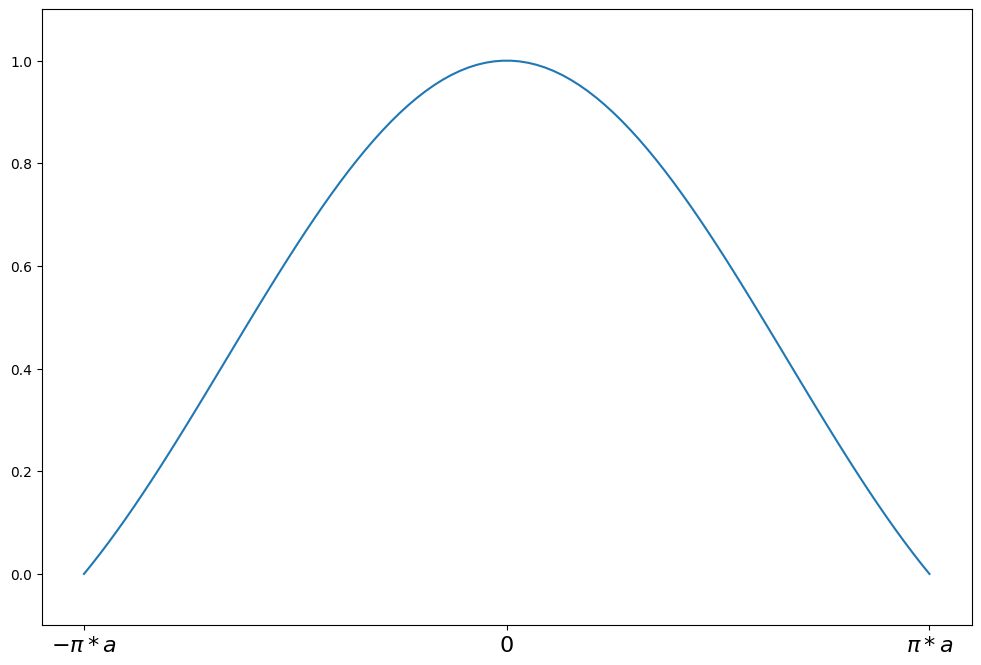
Hampel's 17A¶
[7]:
help(norms.Hampel.weights)
Help on function weights in module statsmodels.robust.norms:
weights(self, z)
Hampel weighting function for the IRLS algorithm
The psi function scaled by z
Parameters
----------
z : array_like
1d array
Returns
-------
weights : ndarray
weights(z) = 1 for \|z\| <= a
weights(z) = a/\|z\| for a < \|z\| <= b
weights(z) = a*(c - \|z\|)/(\|z\|*(c-b)) for b < \|z\| <= c
weights(z) = 0 for \|z\| > c
[8]:
c = 8
support = np.linspace(-3 * c, 3 * c, 1000)
hampel = norms.Hampel(a=2.0, b=4.0, c=c)
plot_weights(support, hampel.weights, ["3*c", "0", "3*c"], [-3 * c, 0, 3 * c])
[8]:
<Axes: >
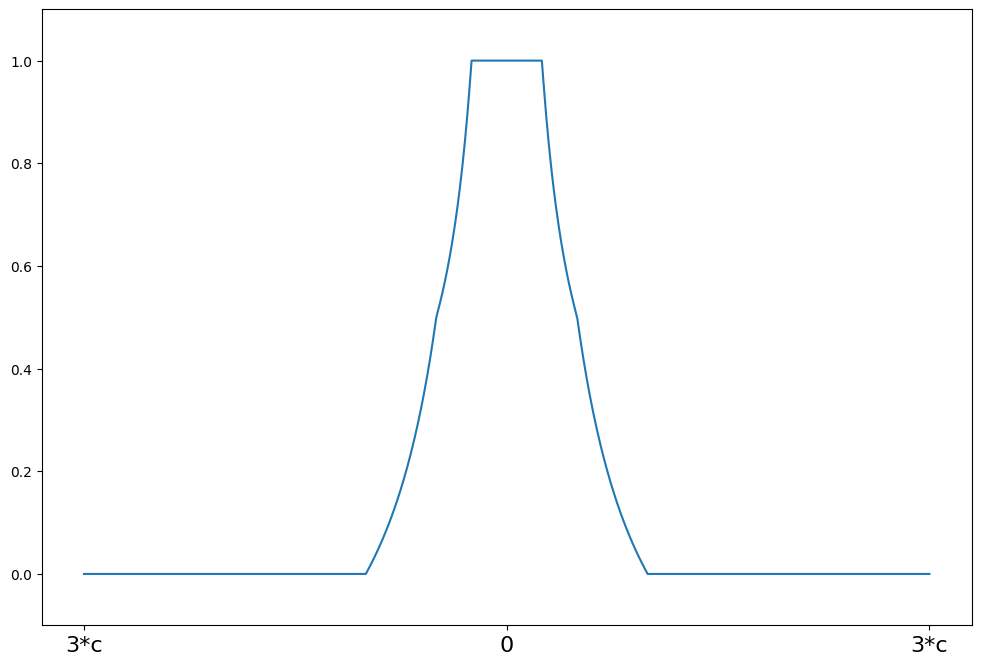
Huber's t¶
[9]:
help(norms.HuberT.weights)
Help on function weights in module statsmodels.robust.norms:
weights(self, z)
Huber's t weighting function for the IRLS algorithm
The psi function scaled by z
Parameters
----------
z : array_like
1d array
Returns
-------
weights : ndarray
weights(z) = 1 for \|z\| <= t
weights(z) = t/\|z\| for \|z\| > t
[10]:
t = 1.345
support = np.linspace(-3 * t, 3 * t, 1000)
huber = norms.HuberT(t=t)
plot_weights(support, huber.weights, ["-3*t", "0", "3*t"], [-3 * t, 0, 3 * t])
[10]:
<Axes: >
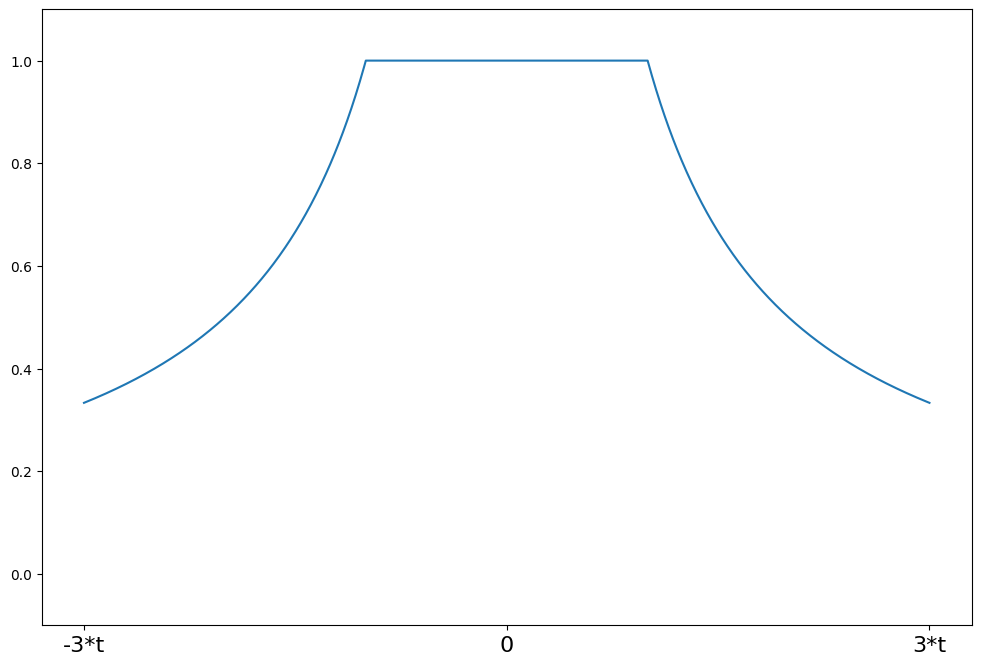
最小二乘法¶
[11]:
help(norms.LeastSquares.weights)
Help on function weights in module statsmodels.robust.norms:
weights(self, z)
The least squares estimator weighting function for the IRLS algorithm.
The psi function scaled by the input z
Parameters
----------
z : array_like
1d array
Returns
-------
weights : ndarray
weights(z) = np.ones(z.shape)
[12]:
support = np.linspace(-3, 3, 1000)
lst_sq = norms.LeastSquares()
plot_weights(support, lst_sq.weights, ["-3", "0", "3"], [-3, 0, 3])
[12]:
<Axes: >
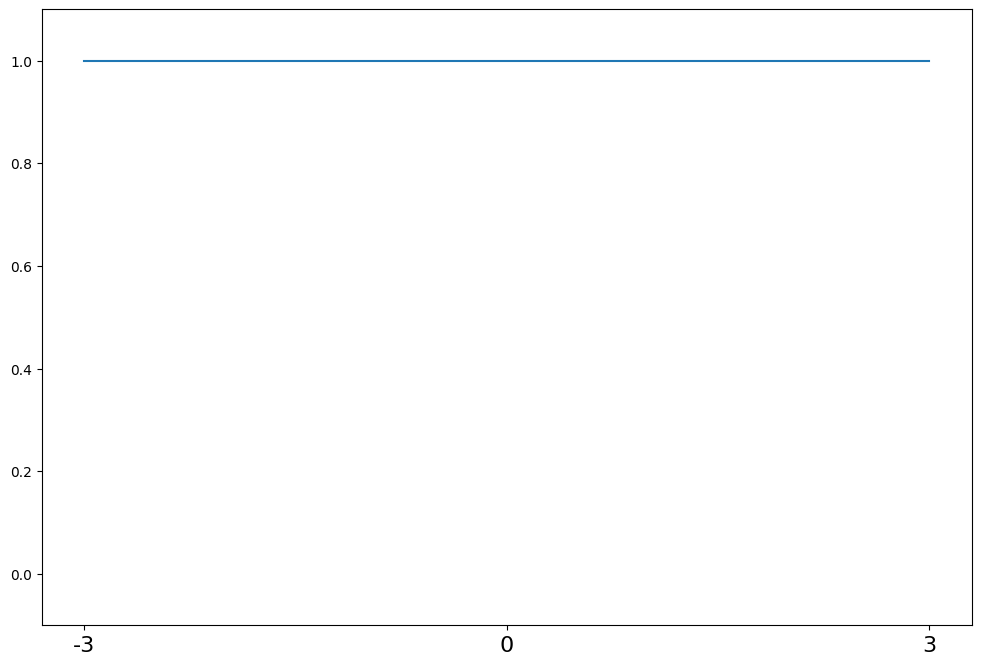
Ramsay's Ea¶
[13]:
help(norms.RamsayE.weights)
Help on function weights in module statsmodels.robust.norms:
weights(self, z)
Ramsay's Ea weighting function for the IRLS algorithm
The psi function scaled by z
Parameters
----------
z : array_like
1d array
Returns
-------
weights : ndarray
weights(z) = exp(-a*\|z\|)
[14]:
a = 0.3
support = np.linspace(-3 * a, 3 * a, 1000)
ramsay = norms.RamsayE(a=a)
plot_weights(support, ramsay.weights, ["-3*a", "0", "3*a"], [-3 * a, 0, 3 * a])
[14]:
<Axes: >
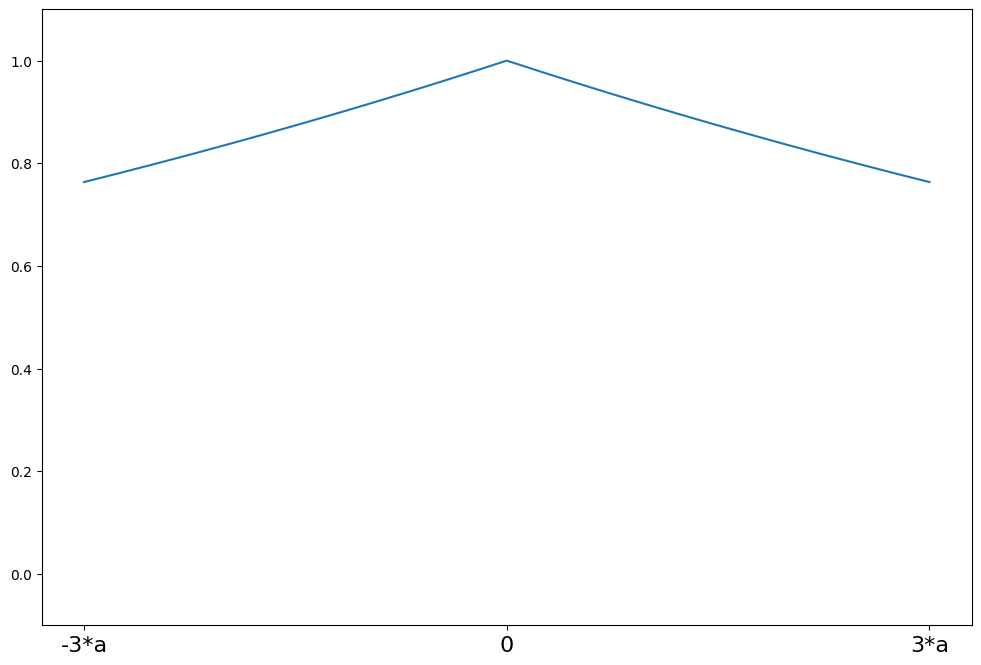
截断均值¶
[15]:
help(norms.TrimmedMean.weights)
Help on function weights in module statsmodels.robust.norms:
weights(self, z)
Least trimmed mean weighting function for the IRLS algorithm
The psi function scaled by z
Parameters
----------
z : array_like
1d array
Returns
-------
weights : ndarray
weights(z) = 1 for \|z\| <= c
weights(z) = 0 for \|z\| > c
[16]:
c = 2
support = np.linspace(-3 * c, 3 * c, 1000)
trimmed = norms.TrimmedMean(c=c)
plot_weights(support, trimmed.weights, ["-3*c", "0", "3*c"], [-3 * c, 0, 3 * c])
[16]:
<Axes: >
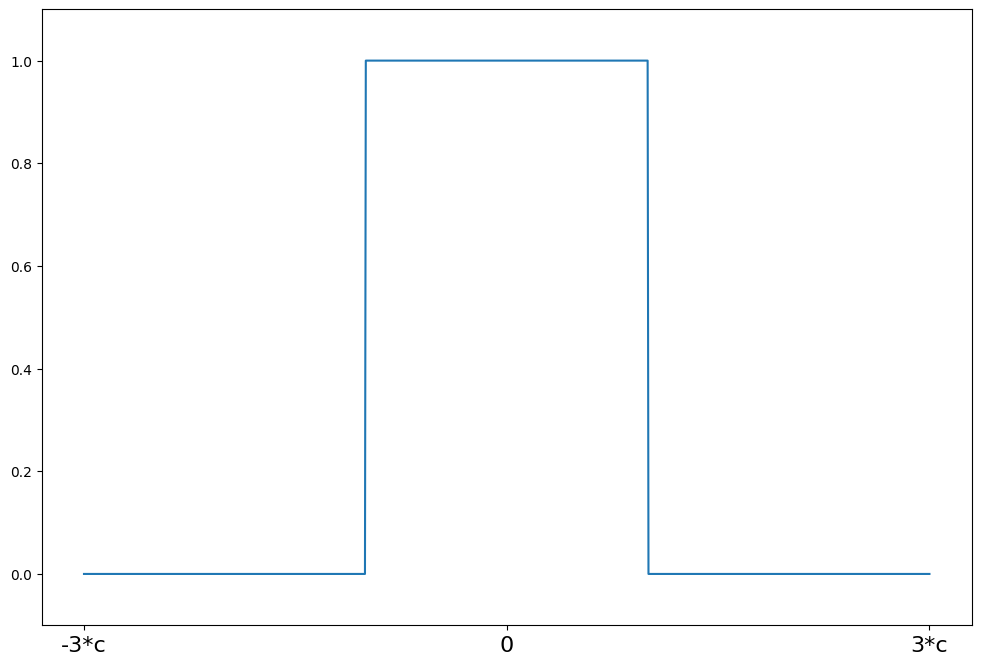
Tukey's Biweight¶
[17]:
help(norms.TukeyBiweight.weights)
Help on function weights in module statsmodels.robust.norms:
weights(self, z)
Tukey's biweight weighting function for the IRLS algorithm
The psi function scaled by z
Parameters
----------
z : array_like
1d array
Returns
-------
weights : ndarray
psi(z) = (1 - (z/c)**2)**2 for \|z\| <= R
psi(z) = 0 for \|z\| > R
[18]:
c = 4.685
support = np.linspace(-3 * c, 3 * c, 1000)
tukey = norms.TukeyBiweight(c=c)
plot_weights(support, tukey.weights, ["-3*c", "0", "3*c"], [-3 * c, 0, 3 * c])
[18]:
<Axes: >
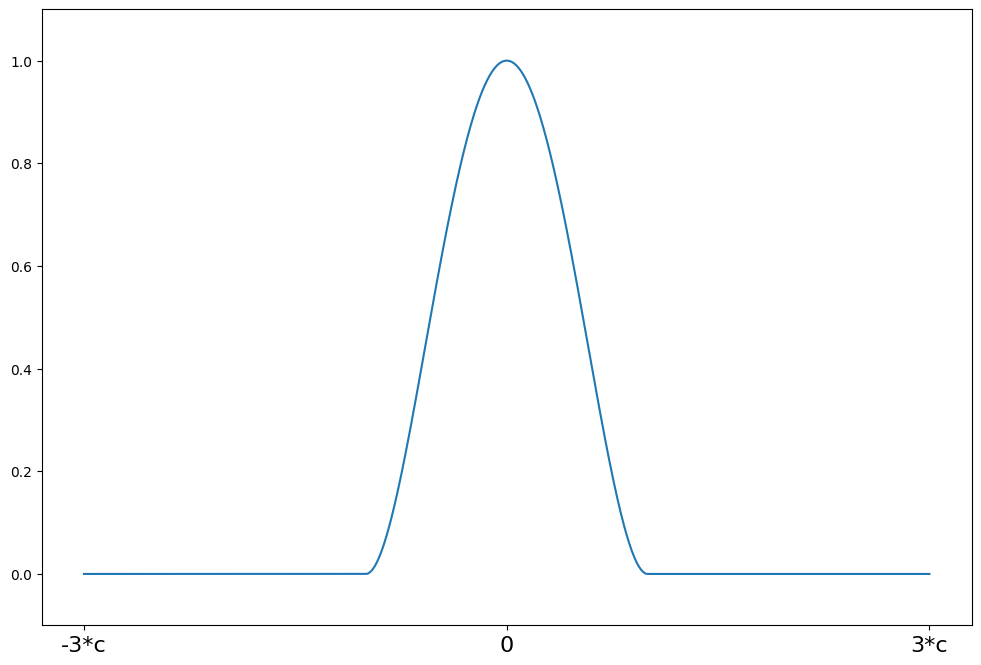
尺度估计量¶
位置的稳健估计量
[19]:
x = np.array([1, 2, 3, 4, 500])
均值不是位置的稳健估计量
[20]:
x.mean()
[20]:
np.float64(102.0)
另一方面,中位数是一个稳健的估计量,其崩溃点为 50%
[21]:
np.median(x)
[21]:
np.float64(3.0)
类似地,对于尺度
标准差不是稳健的
[22]:
x.std()
[22]:
np.float64(199.00251254695254)
中位数绝对偏差
标准化中位数绝对偏差是 \(\hat{\sigma}\) 的一致估计量
其中 \(K\) 取决于分布。例如,对于正态分布,
[23]:
stats.norm.ppf(0.75)
[23]:
np.float64(0.6744897501960817)
[24]:
print(x)
[ 1 2 3 4 500]
[25]:
sm.robust.scale.mad(x)
[25]:
np.float64(1.482602218505602)
[26]:
np.array([1, 2, 3, 4, 5.0]).std()
[26]:
np.float64(1.4142135623730951)
另一个稳健的尺度估计量是四分位距 (IQR)
其中 \(\hat{X}_{p}\) 是样本第 p 个分位数,\(K\) 取决于分布。
标准化 IQR,由 \(K \cdot \text{IQR}\) 给出,对于
是正态数据标准差的一致估计量。
[27]:
sm.robust.scale.iqr(x)
[27]:
array(1.48260222)
IQR 在稳健性方面不如 MAD,因为它的崩溃点较低:它可以承受 25% 的异常观察值,而不会被完全破坏,而 MAD 可以承受 50% 的异常观察值。但是,IQR 更适合非对称分布。
另一个稳健的尺度估计量是 \(Q_n\) 估计量,由 Rousseeuw & Croux (1993) 在“中位数绝对偏差的替代方法”中引入。然后 \(Q_n\) 估计量由下式给出
其中 \(h\approx (1/4){{n}\choose{2}}\) 且 \(K\) 是给定的常数。换句话说,\(Q_n\) 估计量是数据绝对差的第 \(h\) 个顺序统计量的归一化结果。归一化常数 \(K\) 通常选择为 2.219144,以使估计量在正态数据情况下与标准差一致。\(Q_n\) 估计量的崩溃点为 50%,在正态分布时的渐近效率为 82%,远高于 MAD 的 37% 效率。
[28]:
sm.robust.scale.qn_scale(x)
[28]:
2.219144465985076
稳健线性模型的默认值为 MAD
另一个流行的选择是 Huber's proposal 2
[29]:
np.random.seed(12345)
fat_tails = stats.t(6).rvs(40)
[30]:
kde = sm.nonparametric.KDEUnivariate(fat_tails)
kde.fit()
fig = plt.figure(figsize=(12, 8))
ax = fig.add_subplot(111)
ax.plot(kde.support, kde.density)
[30]:
[<matplotlib.lines.Line2D at 0x7f1eaab6baf0>]
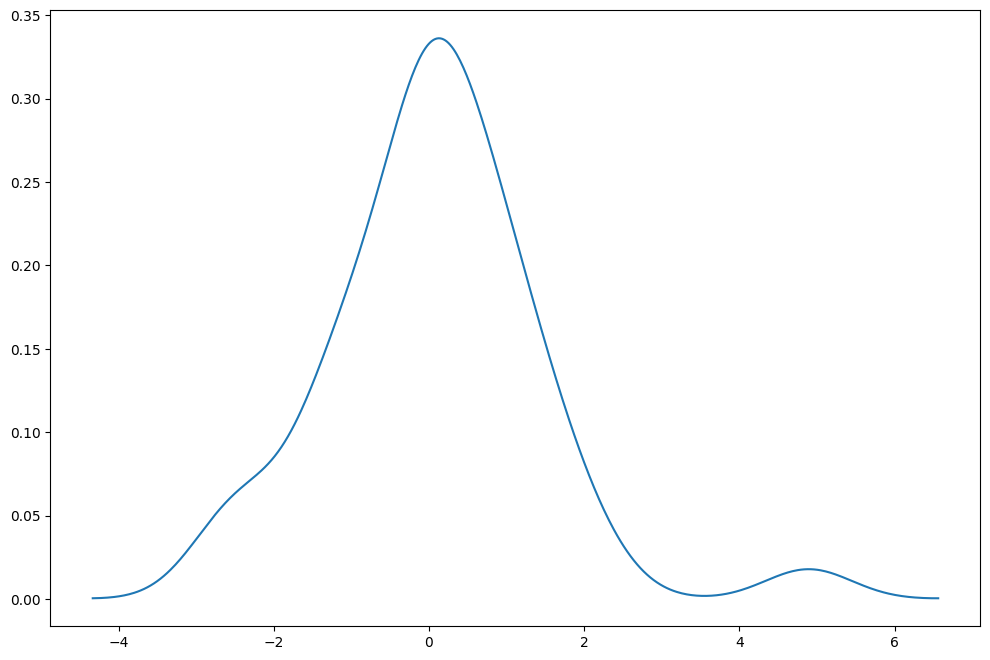
[31]:
print(fat_tails.mean(), fat_tails.std())
0.0688231044810875 1.3471633229698652
[32]:
print(stats.norm.fit(fat_tails))
(np.float64(0.0688231044810875), np.float64(1.3471633229698652))
[33]:
print(stats.t.fit(fat_tails, f0=6))
(6, np.float64(0.03900835312789366), np.float64(1.0563837144431252))
[34]:
huber = sm.robust.scale.Huber()
loc, scale = huber(fat_tails)
print(loc, scale)
0.04048984333271795 1.1557140047569665
[35]:
sm.robust.mad(fat_tails)
[35]:
np.float64(1.115335001165415)
[36]:
sm.robust.mad(fat_tails, c=stats.t(6).ppf(0.75))
[36]:
np.float64(1.0483916565928972)
[37]:
sm.robust.scale.mad(fat_tails)
[37]:
np.float64(1.115335001165415)
Duncan's 职业声望数据 - M估计异常值¶
[38]:
from statsmodels.graphics.api import abline_plot
from statsmodels.formula.api import ols, rlm
[39]:
prestige = sm.datasets.get_rdataset("Duncan", "carData", cache=True).data
[40]:
print(prestige.head(10))
type income education prestige
rownames
accountant prof 62 86 82
pilot prof 72 76 83
architect prof 75 92 90
author prof 55 90 76
chemist prof 64 86 90
minister prof 21 84 87
professor prof 64 93 93
dentist prof 80 100 90
reporter wc 67 87 52
engineer prof 72 86 88
[41]:
fig = plt.figure(figsize=(12, 12))
ax1 = fig.add_subplot(211, xlabel="Income", ylabel="Prestige")
ax1.scatter(prestige.income, prestige.prestige)
xy_outlier = prestige.loc["minister", ["income", "prestige"]]
ax1.annotate("Minister", xy_outlier, xy_outlier + 1, fontsize=16)
ax2 = fig.add_subplot(212, xlabel="Education", ylabel="Prestige")
ax2.scatter(prestige.education, prestige.prestige)
[41]:
<matplotlib.collections.PathCollection at 0x7f1eaaa78670>
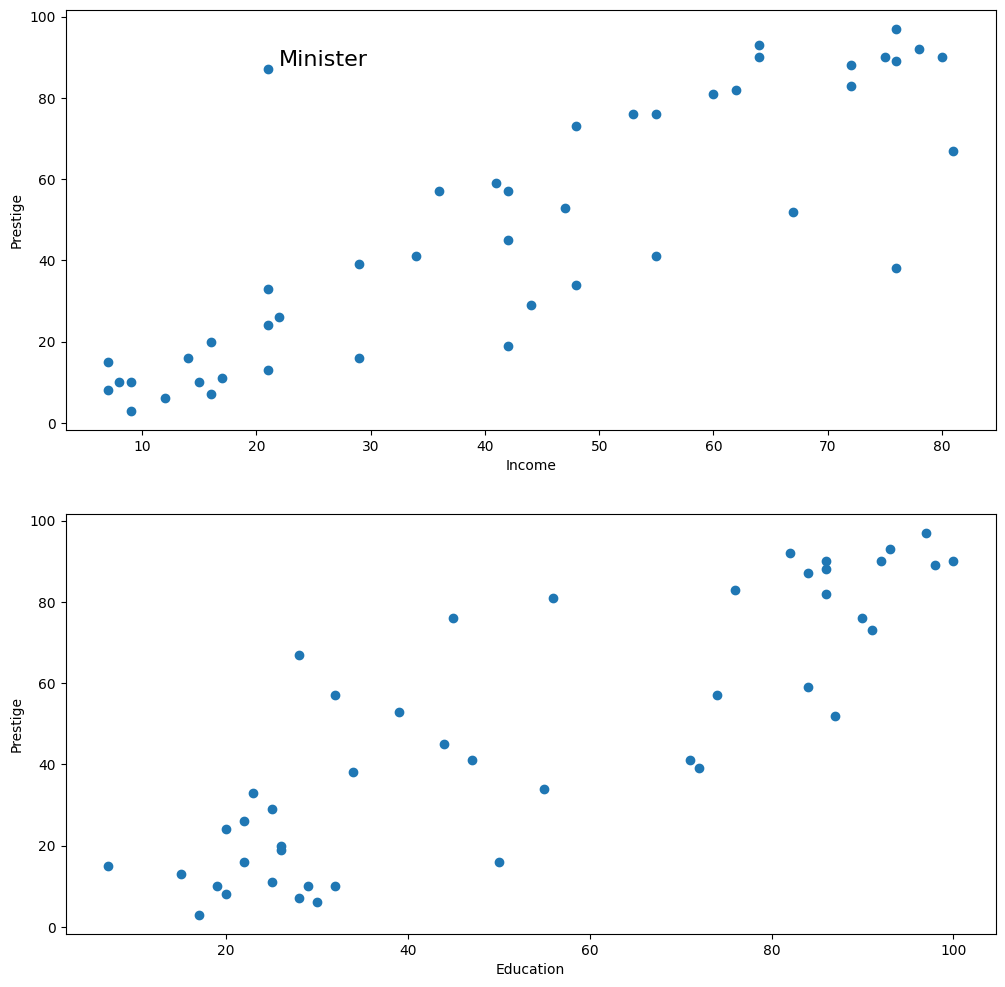
[42]:
ols_model = ols("prestige ~ income + education", prestige).fit()
print(ols_model.summary())
OLS Regression Results
==============================================================================
Dep. Variable: prestige R-squared: 0.828
Model: OLS Adj. R-squared: 0.820
Method: Least Squares F-statistic: 101.2
Date: Thu, 03 Oct 2024 Prob (F-statistic): 8.65e-17
Time: 15:58:23 Log-Likelihood: -178.98
No. Observations: 45 AIC: 364.0
Df Residuals: 42 BIC: 369.4
Df Model: 2
Covariance Type: nonrobust
==============================================================================
coef std err t P>|t| [0.025 0.975]
------------------------------------------------------------------------------
Intercept -6.0647 4.272 -1.420 0.163 -14.686 2.556
income 0.5987 0.120 5.003 0.000 0.357 0.840
education 0.5458 0.098 5.555 0.000 0.348 0.744
==============================================================================
Omnibus: 1.279 Durbin-Watson: 1.458
Prob(Omnibus): 0.528 Jarque-Bera (JB): 0.520
Skew: 0.155 Prob(JB): 0.771
Kurtosis: 3.426 Cond. No. 163.
==============================================================================
Notes:
[1] Standard Errors assume that the covariance matrix of the errors is correctly specified.
[43]:
infl = ols_model.get_influence()
student = infl.summary_frame()["student_resid"]
print(student)
rownames
accountant 0.303900
pilot 0.340920
architect 0.072256
author 0.000711
chemist 0.826578
minister 3.134519
professor 0.768277
dentist -0.498082
reporter -2.397022
engineer 0.306225
undertaker -0.187339
lawyer -0.303082
physician 0.355687
welfare.worker -0.411406
teacher 0.050510
conductor -1.704032
contractor 2.043805
factory.owner 1.602429
store.manager 0.142425
banker 0.508388
bookkeeper -0.902388
mail.carrier -1.433249
insurance.agent -1.930919
store.clerk -1.760491
carpenter 1.068858
electrician 0.731949
RR.engineer 0.808922
machinist 1.887047
auto.repairman 0.522735
plumber -0.377954
gas.stn.attendant -0.666596
coal.miner 1.018527
streetcar.motorman -1.104485
taxi.driver 0.023322
truck.driver -0.129227
machine.operator 0.499922
barber 0.173805
bartender -0.902422
shoe.shiner -0.429357
cook 0.127207
soda.clerk -0.883095
watchman -0.513502
janitor -0.079890
policeman 0.078847
waiter -0.475972
Name: student_resid, dtype: float64
[44]:
print(student.loc[np.abs(student) > 2])
rownames
minister 3.134519
reporter -2.397022
contractor 2.043805
Name: student_resid, dtype: float64
[45]:
print(infl.summary_frame().loc["minister"])
dfb_Intercept 0.144937
dfb_income -1.220939
dfb_education 1.263019
cooks_d 0.566380
standard_resid 2.849416
hat_diag 0.173058
dffits_internal 1.303510
student_resid 3.134519
dffits 1.433935
Name: minister, dtype: float64
[46]:
sidak = ols_model.outlier_test("sidak")
sidak.sort_values("unadj_p", inplace=True)
print(sidak)
student_resid unadj_p sidak(p)
minister 3.134519 0.003177 0.133421
reporter -2.397022 0.021170 0.618213
contractor 2.043805 0.047433 0.887721
insurance.agent -1.930919 0.060428 0.939485
machinist 1.887047 0.066248 0.954247
store.clerk -1.760491 0.085783 0.982331
conductor -1.704032 0.095944 0.989315
factory.owner 1.602429 0.116738 0.996250
mail.carrier -1.433249 0.159369 0.999595
streetcar.motorman -1.104485 0.275823 1.000000
carpenter 1.068858 0.291386 1.000000
coal.miner 1.018527 0.314400 1.000000
bartender -0.902422 0.372104 1.000000
bookkeeper -0.902388 0.372122 1.000000
soda.clerk -0.883095 0.382334 1.000000
chemist 0.826578 0.413261 1.000000
RR.engineer 0.808922 0.423229 1.000000
professor 0.768277 0.446725 1.000000
electrician 0.731949 0.468363 1.000000
gas.stn.attendant -0.666596 0.508764 1.000000
auto.repairman 0.522735 0.603972 1.000000
watchman -0.513502 0.610357 1.000000
banker 0.508388 0.613906 1.000000
machine.operator 0.499922 0.619802 1.000000
dentist -0.498082 0.621088 1.000000
waiter -0.475972 0.636621 1.000000
shoe.shiner -0.429357 0.669912 1.000000
welfare.worker -0.411406 0.682918 1.000000
plumber -0.377954 0.707414 1.000000
physician 0.355687 0.723898 1.000000
pilot 0.340920 0.734905 1.000000
engineer 0.306225 0.760983 1.000000
accountant 0.303900 0.762741 1.000000
lawyer -0.303082 0.763360 1.000000
undertaker -0.187339 0.852319 1.000000
barber 0.173805 0.862874 1.000000
store.manager 0.142425 0.887442 1.000000
truck.driver -0.129227 0.897810 1.000000
cook 0.127207 0.899399 1.000000
janitor -0.079890 0.936713 1.000000
policeman 0.078847 0.937538 1.000000
architect 0.072256 0.942750 1.000000
teacher 0.050510 0.959961 1.000000
taxi.driver 0.023322 0.981507 1.000000
author 0.000711 0.999436 1.000000
[47]:
fdr = ols_model.outlier_test("fdr_bh")
fdr.sort_values("unadj_p", inplace=True)
print(fdr)
student_resid unadj_p fdr_bh(p)
minister 3.134519 0.003177 0.142974
reporter -2.397022 0.021170 0.476332
contractor 2.043805 0.047433 0.596233
insurance.agent -1.930919 0.060428 0.596233
machinist 1.887047 0.066248 0.596233
store.clerk -1.760491 0.085783 0.616782
conductor -1.704032 0.095944 0.616782
factory.owner 1.602429 0.116738 0.656653
mail.carrier -1.433249 0.159369 0.796844
streetcar.motorman -1.104485 0.275823 0.999436
carpenter 1.068858 0.291386 0.999436
coal.miner 1.018527 0.314400 0.999436
bartender -0.902422 0.372104 0.999436
bookkeeper -0.902388 0.372122 0.999436
soda.clerk -0.883095 0.382334 0.999436
chemist 0.826578 0.413261 0.999436
RR.engineer 0.808922 0.423229 0.999436
professor 0.768277 0.446725 0.999436
electrician 0.731949 0.468363 0.999436
gas.stn.attendant -0.666596 0.508764 0.999436
auto.repairman 0.522735 0.603972 0.999436
watchman -0.513502 0.610357 0.999436
banker 0.508388 0.613906 0.999436
machine.operator 0.499922 0.619802 0.999436
dentist -0.498082 0.621088 0.999436
waiter -0.475972 0.636621 0.999436
shoe.shiner -0.429357 0.669912 0.999436
welfare.worker -0.411406 0.682918 0.999436
plumber -0.377954 0.707414 0.999436
physician 0.355687 0.723898 0.999436
pilot 0.340920 0.734905 0.999436
engineer 0.306225 0.760983 0.999436
accountant 0.303900 0.762741 0.999436
lawyer -0.303082 0.763360 0.999436
undertaker -0.187339 0.852319 0.999436
barber 0.173805 0.862874 0.999436
store.manager 0.142425 0.887442 0.999436
truck.driver -0.129227 0.897810 0.999436
cook 0.127207 0.899399 0.999436
janitor -0.079890 0.936713 0.999436
policeman 0.078847 0.937538 0.999436
architect 0.072256 0.942750 0.999436
teacher 0.050510 0.959961 0.999436
taxi.driver 0.023322 0.981507 0.999436
author 0.000711 0.999436 0.999436
[48]:
rlm_model = rlm("prestige ~ income + education", prestige).fit()
print(rlm_model.summary())
Robust linear Model Regression Results
==============================================================================
Dep. Variable: prestige No. Observations: 45
Model: RLM Df Residuals: 42
Method: IRLS Df Model: 2
Norm: HuberT
Scale Est.: mad
Cov Type: H1
Date: Thu, 03 Oct 2024
Time: 15:58:23
No. Iterations: 18
==============================================================================
coef std err z P>|z| [0.025 0.975]
------------------------------------------------------------------------------
Intercept -7.1107 3.879 -1.833 0.067 -14.713 0.492
income 0.7015 0.109 6.456 0.000 0.489 0.914
education 0.4854 0.089 5.441 0.000 0.311 0.660
==============================================================================
If the model instance has been used for another fit with different fit parameters, then the fit options might not be the correct ones anymore .
[49]:
print(rlm_model.weights)
rownames
accountant 1.000000
pilot 1.000000
architect 1.000000
author 1.000000
chemist 1.000000
minister 0.344596
professor 1.000000
dentist 1.000000
reporter 0.441669
engineer 1.000000
undertaker 1.000000
lawyer 1.000000
physician 1.000000
welfare.worker 1.000000
teacher 1.000000
conductor 0.538445
contractor 0.552262
factory.owner 0.706169
store.manager 1.000000
banker 1.000000
bookkeeper 1.000000
mail.carrier 0.690764
insurance.agent 0.533499
store.clerk 0.618656
carpenter 0.935848
electrician 1.000000
RR.engineer 1.000000
machinist 0.570360
auto.repairman 1.000000
plumber 1.000000
gas.stn.attendant 1.000000
coal.miner 0.963821
streetcar.motorman 0.832870
taxi.driver 1.000000
truck.driver 1.000000
machine.operator 1.000000
barber 1.000000
bartender 1.000000
shoe.shiner 1.000000
cook 1.000000
soda.clerk 1.000000
watchman 1.000000
janitor 1.000000
policeman 1.000000
waiter 1.000000
dtype: float64
Hertzprung Russell 星团 CYG 0B1 的数据 - 杠杆点¶
数据是天鹅座方向上 47 颗恒星的光度和温度。
[50]:
dta = sm.datasets.get_rdataset("starsCYG", "robustbase", cache=True).data
[51]:
from matplotlib.patches import Ellipse
fig = plt.figure(figsize=(12, 8))
ax = fig.add_subplot(
111,
xlabel="log(Temp)",
ylabel="log(Light)",
title="Hertzsprung-Russell Diagram of Star Cluster CYG OB1",
)
ax.scatter(*dta.values.T)
# highlight outliers
e = Ellipse((3.5, 6), 0.2, 1, alpha=0.25, color="r")
ax.add_patch(e)
ax.annotate(
"Red giants",
xy=(3.6, 6),
xytext=(3.8, 6),
arrowprops=dict(facecolor="black", shrink=0.05, width=2),
horizontalalignment="left",
verticalalignment="bottom",
clip_on=True, # clip to the axes bounding box
fontsize=16,
)
# annotate these with their index
for i, row in dta.loc[dta["log.Te"] < 3.8].iterrows():
ax.annotate(i, row, row + 0.01, fontsize=14)
xlim, ylim = ax.get_xlim(), ax.get_ylim()
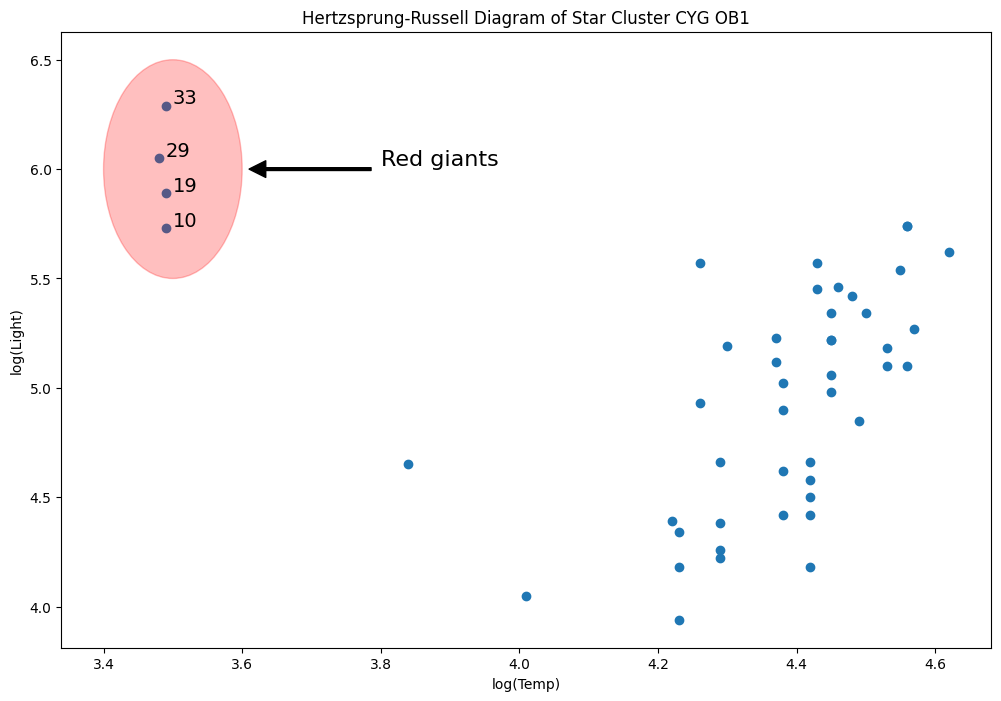
[52]:
from IPython.display import Image
Image(filename="star_diagram.png")
[52]:

[53]:
y = dta["log.light"]
X = sm.add_constant(dta["log.Te"], prepend=True)
ols_model = sm.OLS(y, X).fit()
abline_plot(model_results=ols_model, ax=ax)
[53]:
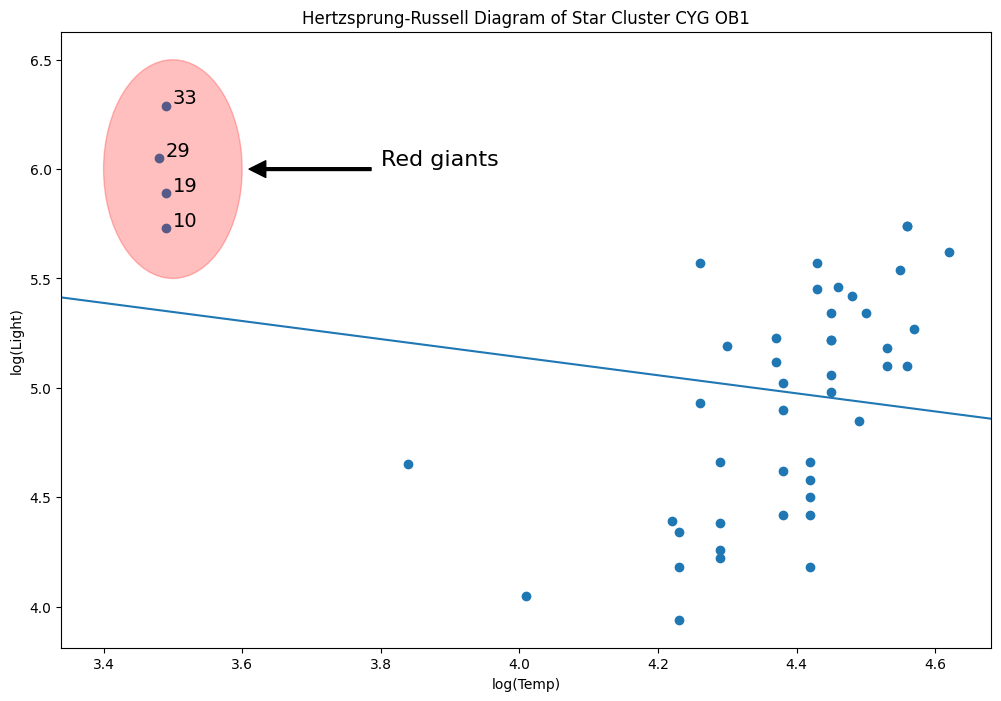
[54]:
rlm_mod = sm.RLM(y, X, sm.robust.norms.TrimmedMean(0.5)).fit()
abline_plot(model_results=rlm_mod, ax=ax, color="red")
[54]:
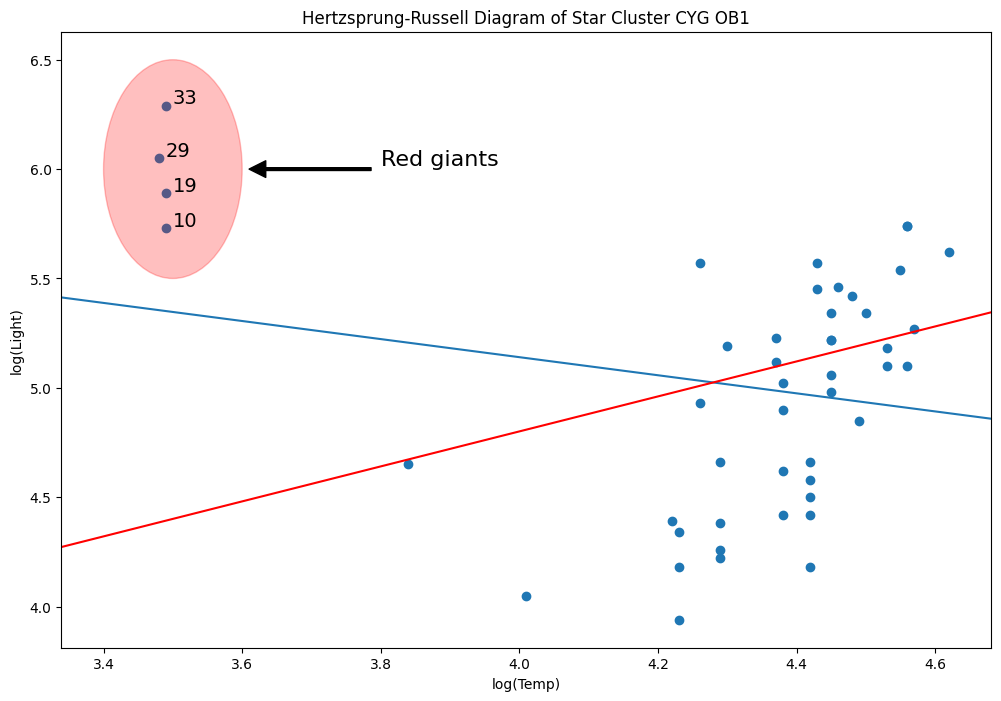
为什么?因为 M估计量对杠杆点不稳健。
[55]:
infl = ols_model.get_influence()
[56]:
h_bar = 2 * (ols_model.df_model + 1) / ols_model.nobs
hat_diag = infl.summary_frame()["hat_diag"]
hat_diag.loc[hat_diag > h_bar]
[56]:
10 0.194103
19 0.194103
29 0.198344
33 0.194103
Name: hat_diag, dtype: float64
[57]:
sidak2 = ols_model.outlier_test("sidak")
sidak2.sort_values("unadj_p", inplace=True)
print(sidak2)
student_resid unadj_p sidak(p)
16 -2.049393 0.046415 0.892872
13 -2.035329 0.047868 0.900286
33 1.905847 0.063216 0.953543
18 -1.575505 0.122304 0.997826
3 1.522185 0.135118 0.998911
1 1.522185 0.135118 0.998911
21 -1.450418 0.154034 0.999615
17 -1.426675 0.160731 0.999735
29 1.388520 0.171969 0.999859
14 -1.374733 0.176175 0.999889
35 1.346543 0.185023 0.999933
34 -1.272159 0.209999 0.999985
28 -1.186946 0.241618 0.999998
20 -1.150621 0.256103 0.999999
44 1.134779 0.262612 0.999999
39 1.091886 0.280826 1.000000
19 1.064878 0.292740 1.000000
6 -1.026873 0.310093 1.000000
30 -1.009096 0.318446 1.000000
22 -0.979768 0.332557 1.000000
8 0.961218 0.341695 1.000000
5 0.913802 0.365801 1.000000
11 0.871997 0.387943 1.000000
12 0.856685 0.396261 1.000000
46 -0.833923 0.408829 1.000000
10 0.743920 0.460879 1.000000
42 0.727179 0.470968 1.000000
15 -0.689258 0.494280 1.000000
43 0.688272 0.494895 1.000000
7 0.655712 0.515424 1.000000
40 -0.646396 0.521381 1.000000
26 -0.640978 0.524862 1.000000
25 -0.545561 0.588123 1.000000
37 0.472819 0.638680 1.000000
32 0.472819 0.638680 1.000000
38 0.462187 0.646225 1.000000
0 0.430686 0.668799 1.000000
31 0.341726 0.734184 1.000000
36 0.318911 0.751303 1.000000
4 0.307890 0.759619 1.000000
9 0.235114 0.815211 1.000000
41 0.187732 0.851950 1.000000
2 -0.182093 0.856346 1.000000
23 -0.156014 0.876736 1.000000
27 -0.147406 0.883485 1.000000
24 0.065195 0.948314 1.000000
45 0.045675 0.963776 1.000000
[58]:
fdr2 = ols_model.outlier_test("fdr_bh")
fdr2.sort_values("unadj_p", inplace=True)
print(fdr2)
student_resid unadj_p fdr_bh(p)
16 -2.049393 0.046415 0.764747
13 -2.035329 0.047868 0.764747
33 1.905847 0.063216 0.764747
18 -1.575505 0.122304 0.764747
3 1.522185 0.135118 0.764747
1 1.522185 0.135118 0.764747
21 -1.450418 0.154034 0.764747
17 -1.426675 0.160731 0.764747
29 1.388520 0.171969 0.764747
14 -1.374733 0.176175 0.764747
35 1.346543 0.185023 0.764747
34 -1.272159 0.209999 0.764747
28 -1.186946 0.241618 0.764747
20 -1.150621 0.256103 0.764747
44 1.134779 0.262612 0.764747
39 1.091886 0.280826 0.764747
19 1.064878 0.292740 0.764747
6 -1.026873 0.310093 0.764747
30 -1.009096 0.318446 0.764747
22 -0.979768 0.332557 0.764747
8 0.961218 0.341695 0.764747
5 0.913802 0.365801 0.768599
11 0.871997 0.387943 0.768599
12 0.856685 0.396261 0.768599
46 -0.833923 0.408829 0.768599
10 0.743920 0.460879 0.770890
42 0.727179 0.470968 0.770890
15 -0.689258 0.494280 0.770890
43 0.688272 0.494895 0.770890
7 0.655712 0.515424 0.770890
40 -0.646396 0.521381 0.770890
26 -0.640978 0.524862 0.770890
25 -0.545561 0.588123 0.837630
37 0.472819 0.638680 0.843682
32 0.472819 0.638680 0.843682
38 0.462187 0.646225 0.843682
0 0.430686 0.668799 0.849556
31 0.341726 0.734184 0.892552
36 0.318911 0.751303 0.892552
4 0.307890 0.759619 0.892552
9 0.235114 0.815211 0.922751
41 0.187732 0.851950 0.922751
2 -0.182093 0.856346 0.922751
23 -0.156014 0.876736 0.922751
27 -0.147406 0.883485 0.922751
24 0.065195 0.948314 0.963776
45 0.045675 0.963776 0.963776
让我们删除该行
[59]:
l = ax.lines[-1]
l.remove()
del l
[60]:
weights = np.ones(len(X))
weights[X[X["log.Te"] < 3.8].index.values - 1] = 0
wls_model = sm.WLS(y, X, weights=weights).fit()
abline_plot(model_results=wls_model, ax=ax, color="green")
[60]:
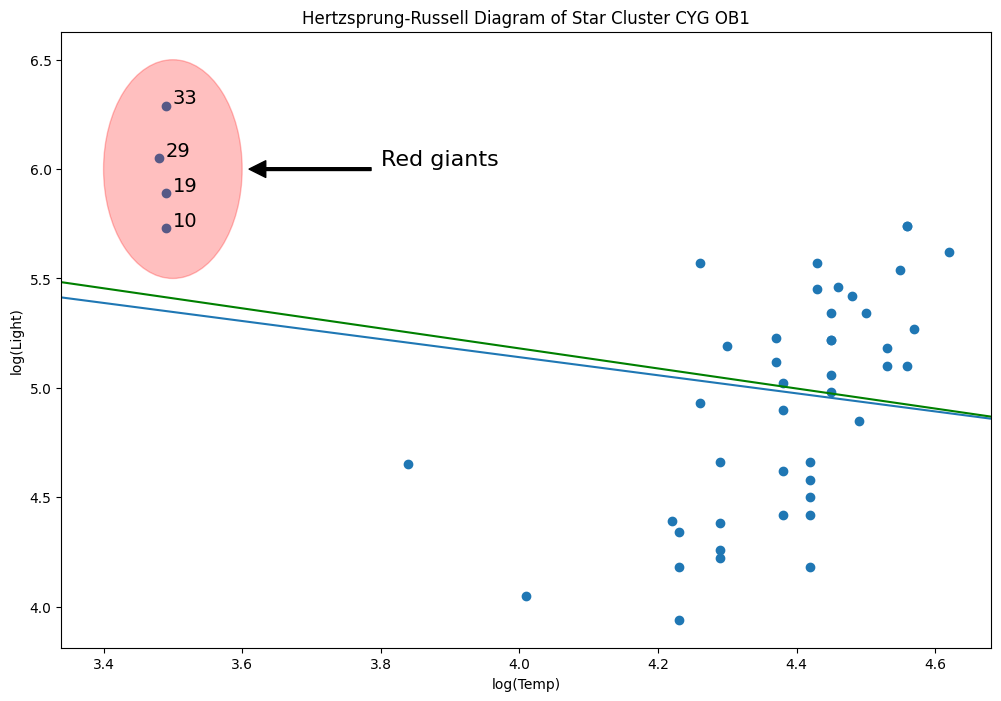
MM 估计量适合解决此类问题,不幸的是,我们还没有这些估计量。
它正在开发中,但它为我们提供了查看笔记本中的 R 单元格魔法的好借口。
[61]:
yy = y.values[:, None]
xx = X["log.Te"].values[:, None]
**注意**:此笔记本中的 R 代码和结果已转换为 Markdown,因此构建文档不需要 R。笔记本中的 R 结果是使用 R 3.5.1 和 robustbase 0.93 计算的。
%load_ext rpy2.ipython
%R library(robustbase)
%Rpush yy xx
%R mod <- lmrob(yy ~ xx);
%R params <- mod$coefficients;
%Rpull params
%R print(mod)
Call:
lmrob(formula = yy ~ xx)
\--> method = "MM"
Coefficients:
(Intercept) xx
-4.969 2.253
[62]:
params = [-4.969387980288108, 2.2531613477892365] # Computed using R
print(params[0], params[1])
-4.969387980288108 2.2531613477892365
[63]:
abline_plot(intercept=params[0], slope=params[1], ax=ax, color="red")
[63]:
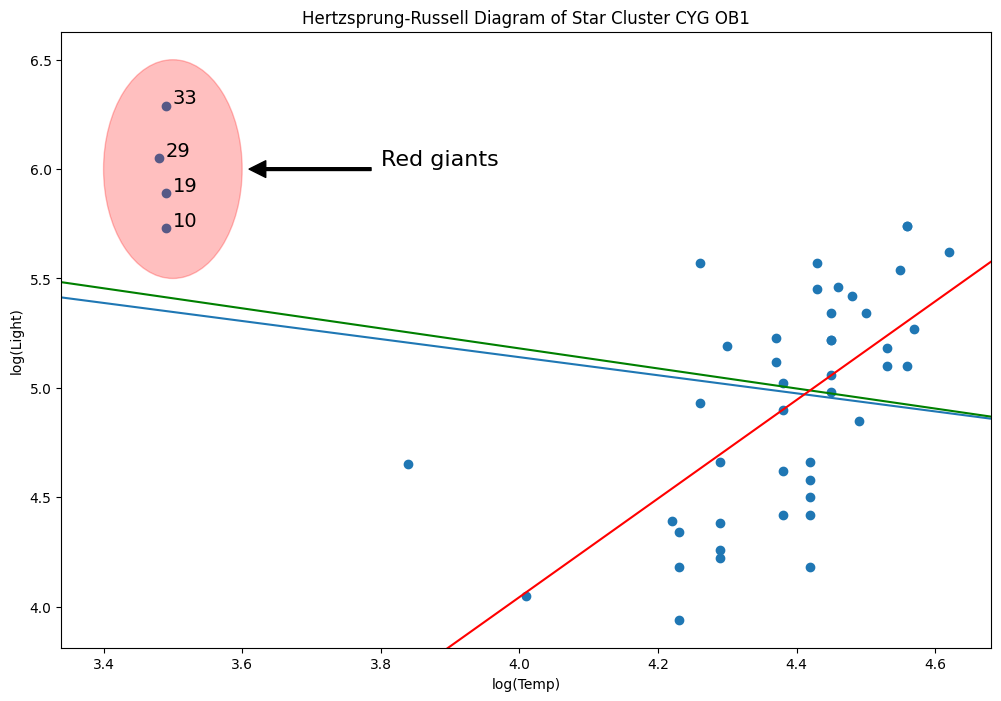
练习:M估计量的崩溃点¶
[64]:
np.random.seed(12345)
nobs = 200
beta_true = np.array([3, 1, 2.5, 3, -4])
X = np.random.uniform(-20, 20, size=(nobs, len(beta_true) - 1))
# stack a constant in front
X = sm.add_constant(X, prepend=True) # np.c_[np.ones(nobs), X]
mc_iter = 500
contaminate = 0.25 # percentage of response variables to contaminate
[65]:
all_betas = []
for i in range(mc_iter):
y = np.dot(X, beta_true) + np.random.normal(size=200)
random_idx = np.random.randint(0, nobs, size=int(contaminate * nobs))
y[random_idx] = np.random.uniform(-750, 750)
beta_hat = sm.RLM(y, X).fit().params
all_betas.append(beta_hat)
[66]:
all_betas = np.asarray(all_betas)
se_loss = lambda x: np.linalg.norm(x, ord=2) ** 2
se_beta = lmap(se_loss, all_betas - beta_true)
平方误差损失¶
[67]:
np.array(se_beta).mean()
[67]:
np.float64(0.44502948730683384)
[68]:
all_betas.mean(0)
[68]:
array([ 2.99711706, 0.99898147, 2.49909344, 2.99712918, -3.99626521])
[69]:
beta_true
[69]:
array([ 3. , 1. , 2.5, 3. , -4. ])
[70]:
se_loss(all_betas.mean(0) - beta_true)
[70]:
np.float64(3.236091328690045e-05)